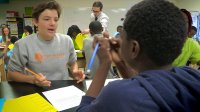4 Tips on Teaching Problem Solving (From a Student)
A student shares her insights into the most important skill you can teach. (Hint: It’s not perseverance.)
Your content has been saved!
Go to My Saved Content.Education is one of the most important things in the world, but at most schools, students are told to memorize facts, formulas, and functions without any applicability to the real challenges we will face later. Instead, give us challenges; give us problems that focus on real-world scenarios; give us a chance to understand the world we’re entering and to be prepared for it before we’re thrown in headfirst.
At Two Rivers Public Charter School, they taught us how to problem solve, and they made it relevant. Here are four tips that engaged me in my learning that you can adapt in your classroom:
1. Give Your Students Hard Problems
In the real world, we’re not going to have nice problems that will be easy to understand. We are going to have complex problems that require a lot more preparation than most math, science, or English classes will give us. The challenges in the real world won’t be simple, and the problems that are supposed to prepare us for that world shouldn't be either.
2. Make Problem Solving Relevant to Your Students’ Lives
In the seventh grade, we looked at statistics concerning racial murders and the jury system. That’s something that is going to affect students later in life, and we got a chance to look at it from a mathematical perspective. Problems like that are actually relevant to us, and they’re not things we’re supposed to just memorize or learn. They are things from which we can take very important life lessons, and then actually apply them later on in life.
Related Article: Solving Real World Issues Through Problem-Based Learning
In the eighth grade, we wrote policy briefs in relation to gene editing and presented them to the National Academies of Sciences, Engineering, and Medicine. We talked to researchers who worked with CRISPR-Cas9 (a gene editing tool used to modify specific genes in organisms), and we studied how gene editing is evolving and how we can use this modern technology for science applications. At the same time, in English, we read The Giver by Lois Lowry and analyzed whether the society in the book was ethical to gain an understanding of what ethical means and how it’s applicable in real situations, like gene editing.
This wasn’t something where we were being told, “Somebody’s going to buy 60 watermelons at a store.” This was actually happening in real life, and the only people really discussing this were people whom it wasn't even going to affect. This science won’t come into widespread use until much later, and we’re going to be the first ones who are actually in danger from the possible consequences of it. By presenting our policy briefs, we had a chance to make an impact and get our voice out there at only 14.
3. Teach Your Students How to Grapple (It’s More Powerful Than Perseverance)
Grappling is like perseverance, but it goes beyond that. Perseverance means trying again and again, even after you’ve failed. Grappling implies trying even before you fail the first time. It’s thinking, “First, I’ll work with it independently. Okay, I’m really not understanding it. Let me go back to my notes. Okay, I have solved for the first part of it. Now I have the second part of it. Okay, I got the question wrong; let me try again. Maybe I can ask my peer now.” Grappling is working hard to make sure you understand the problem fully, and then using every resource at your fingertips to solve it.
4. Put More Importance on Student Understanding Than on Getting the Right Answer
I am graduating from Two Rivers with a practical view of the world. I don’t think that many students come out of middle school saying, “It was great.” And I don’t think many students have had this introduction to our society and its benefits and drawbacks. I’m also coming out of here with incredible problem-solving skills and the ability to look at any problem and have 10,000 ways to solve it in my mind already—because we don’t just memorize functions or the periodic table. We understand why, and we work to understand how to solve a problem instead of just getting the answer.
As students preparing for the real world, it is so much more impactful for us if our learning is relevant and challenging than if it is just about memorizing the right answers.
